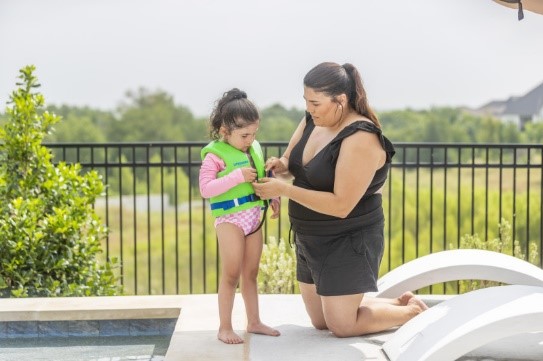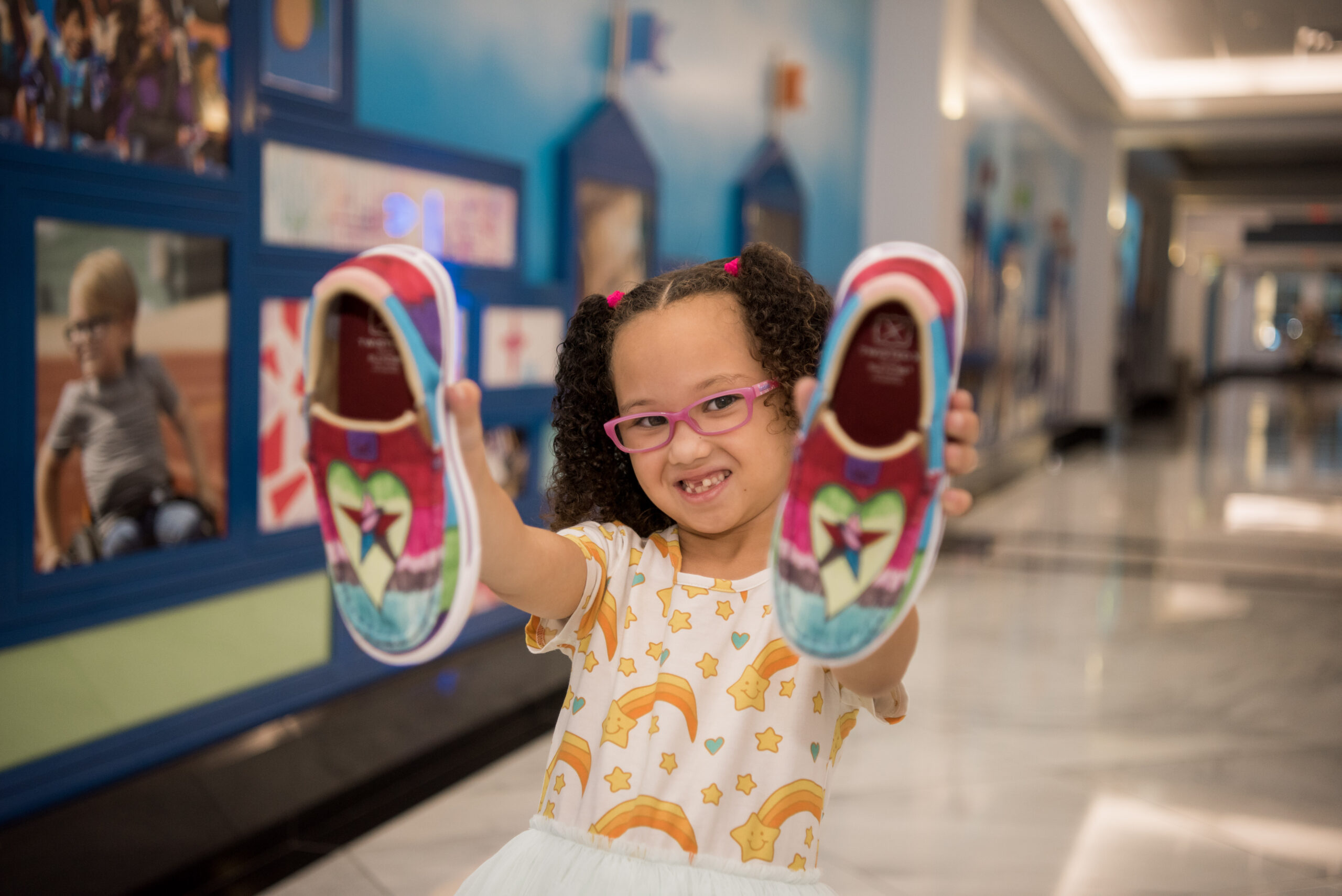Teen Shares Covid-19 Survival Story
During the height of the delta surge of COVID-19, 16-year-old Haylee Richard had to be flown to Cook Children’s where she fought against the odds for her life.
Video here: Survival Story: Teen Shares Near-Fatal Brush with COVID-19 (checkupnewsroom.com)
It started with a sore throat, then she lost her voice. Three days later test results confirmed Haylee Richard, 16, a Denison High School junior, had Covid-19.
Her mom, Hillary Richard, was concerned, but not overly. She kept an eye on her eldest daughter and monitored her condition. Haylee didn’t have a high fever and the pulse oximeter readings showed her oxygen saturation levels within normal range.
In fact, on Sept. 18, which was the seventh day of being sick, Haylee appeared on the mend, even requesting her favorite Chinese food for dinner. But, without warning, that rapidly changed.

When Hillary went to bed that night, Haylee was asleep, she says. Her daughter had taken a few bites of dinner, but she figured Haylee would wake up to finish it sometime later. But “she took a dive overnight,” Hillary says, adding “she went from OK to not—fast.”
She began feeling weird during the night, Haylee says, and couldn’t sleep. She propped herself up with a mountain of pillows trying to get comfortable. Intense pressure on her chest and lungs made it tough to breathe. She started coughing up bloody phlegm. She checked her oximeter through the night and saw the numbers going down each time. But she was too out-of-it to let her parents—who were sleeping one room over—know how she felt.
“I didn’t really realize what was going on, so I’d try to nod off back to sleep,” Haylee says. “I wasn’t fully present.”
When her mom checked on her the next morning, Haylee didn’t look right. She was extremely pale, Hillary says, and when she checked her oxygen saturation level, it had plummeted to a dangerous 38%. (The normal range is 95% to 100%, and anything under 90% is considered low.)
Her mother immediately called 911 and EMTs arrived within a few minutes. They put Haylee on oxygen and took her by ambulance to the Emergency Department of a local hospital. There, it was determined she had severe Covid-19 pneumonia and needed to be transported to a children’s hospital right away.
At first, they couldn’t find an available bed for her, Hillary says, until Cook Children’s Medical Center offered one. Hillary jumped at it and agreed to a helicopter transport. She wasn’t allowed to accompany Haylee but saw her off, crying as she watched the helicopter take flight with her child inside.
“That’s when it really started sinking in for me,” Hillary says, still emotional as she describes the beginning of Haylee’s battle with COVID-19. “Seeing her take off in that helicopter, and I couldn’t be with her? That was hard, you know? That’s my baby.”
Still in her pajamas, she and her husband, Keith, rushed home, threw some clothes in a bag, jumped back in their truck and barreled toward Fort Worth, the longest most “excruciating ride” she’d ever taken, she says. But the ride ahead was about to become even more rough for her and her family.
Not what a parent wants to hear
Inside the helicopter, Haylee knew her condition wasn’t good, she says, but didn’t grasp the gravity of it. She played on her phone, texting a friend a selfie with the message: “Guess where I am?” Her friend responded, asking what was happening, but Haylee wouldn’t be able to answer that text until almost two weeks later.
“I barely remember anything after arriving on the helicopter,” she says. “I couldn’t stand on my own. I was very weak. My body had kind of given out on me, and the nurses were having to help me into bed. And that’s the last thing I remember.”
Ryan Meyer, M.D., a pediatric intensivist at Cook Children’s, says Haylee was hypoxic (low oxygen levels in the blood) when she arrived. She was put on a BiPAP mask, a noninvasive machine used to oxygenate the blood, and placed in the Intensive Care Unit (ICU).
Initially, Haylee responded to the noninvasive measure, but less than 24 hours later, she began worsening, Dr. Meyer says.
“We take these things one hour at a time, one day at a time. And unfortunately, there came a point when noninvasive therapy was no longer sufficient for her,” he says. “We noticed her breathing was worsening, air movement on her lung exam was worsening and her CO2, meaning her ability to ventilate, was also worsening. Everything continued to decline, including her oxygen saturation.”
Physicians needed to intubate her and put her on a ventilator. But Hillary and her husband initially refused to intubate their daughter.
“You hear the horror stories about people with COVID being intubated and never coming off the ventilator,” she says. “That doctor looked at me and said, ‘Ms. Richard, Haylee’s really sick. If we don’t do this right now, she only has a 10% chance of making it.’

“Wow. I lost it. I just looked at him and said, ‘Save my baby. Please, save my baby,’” she says.
Despite the ventilator, Haylee’s condition continued to wane. In less than an hour, doctors decided she needed to be placed on extracorporeal membrane oxygenation (ECMO), a machine that allows patients’ blood to flow out through a tube into an oxygenator before flowing back into the body, similar to a heart-lung bypass machine used in open-heart surgery.
“Unfortunately, even after she was intubated, there was still great difficulty keeping her oxygen saturation levels at a satisfactory level,” Dr. Meyer says. “We’re not even talking about keeping them in the 90s—we’re talking about keeping them in the 80s.”
Her lungs had gotten too sick to support her oxygen needs, Dr. Meyer says.
“We see this in our teenagers who do wind up being intubated,” he adds. “They have very poor air movement, oftentimes they have white-out of their lungs, and are difficult to manage on a mechanical vent support, even on maximum settings.”
Before her daughter was put on the ventilator, doctors had mentioned the ECMO machine as another possibility if needed, Hillary says. But, in her mind, it was a last resort. Watching Haylee on the ventilator, taking note that her numbers weren’t improving, Hillary knew her daughter was in trouble, she says. Haylee’s respiratory rate remained at about 44 to 48 breaths per minute, she says, more than double the rate it should have been.
She and her husband were taken into a consultation room where a chaplain was waiting to pray with them. The doctor came in, telling them the ventilator wasn’t helping Haylee. They wanted to move forward with ECMO, she says.
“At that point, it’s whatever it takes to save my kid,” Hillary recalls. “He told us there was still only a 40% chance she’d even survive. Those were the worst odds. No parent wants to hear that.”
Eight Long Days
The first few days on ECMO her daughter’s condition remained touch-and-go, Hillary says, adding “she didn’t immediately improve.”
In fact, her daughter started swelling, which scared her. Haylee had an allergy wrist band on, and Hillary would stick her fingers between the band and her daughter’s skin to monitor the swelling.
“I started out with two fingers. It got to where my one finger would barely fit in there,” she says.
Helplessly waiting, Hillary and her husband found themselves staring for hours on end at Haylee and the blinking numbers on the machines connected to their daughter. They slept little and prayed a lot, she says. The doctors prepared them with the possibility Haylee could be on ECMO for six weeks or six months. No one knew for sure.
Hillary fretted over what Haylee might be feeling. They had sedated her daughter, “but they told us she could still hear us,” Hillary says.
“And if she could hear us, I worried about what was going on in her head—was she scared? I didn’t want her to be scared,” she says, even though as a mom, she was terrified seeing her child so ill.
On Day Five a bit of bright news came to the Richard family. An X-ray of Haylee’s lungs showed minor improvement. They shared the hopeful results to their “army” of family and friends who’d been supporting them since Haylee’s hospitalization.
“It felt so good to share some good news,” Hillary says. “So many people were concerned about her and were there for us. We had an army—and we still do.”
On Day Six, another good report came in. The top of Haylee’s lungs opened up. The next day, the left side started opening, Hillary says. The following day, after an X-ray showed her lungs partially cleared, doctors decided to take her off of ECMO.
Haylee stayed on ECMO for eight days—the “longest eight days I’ve ever lived,” Hillary says, adding her daughter stayed on a ventilator another two days after that. She was on ECMO for a shorter period than most patients, Hillary says.
“When they first took out the ventilator, she was able to whisper,” Hillary says. “I will never forget walking into her ICU room, and she says, ‘Hi, Mom.’ And it was like the day she was born all over again, you know. It was the most beautiful sound. I could have had a heaven full of angels singing to me at that point, just to hear her little voice again.”

Hearing Haylee’s voice “gave me that, ‘OK, we’re going to get through this. My baby girl is back,’” she adds.
She attributes Haylee’s recovery to Cook Children’s doctors, nurses, technicians—all who helped during one of her darkest times as a parent.
“They were amazing,” Hillary says. “They made us feel comforted in a time when it was hard to feel good about anything.”
Although Haylee was on the mend, their troubles weren’t entirely over. The medications Haylee received caused side effects, and her blood pressure and blood sugar had to be constantly monitored, Hillary says, but it was so much better than where they’d started out.
The Richard family wasn’t the only ones thrilled to see Haylee off of ECMO. The nursing and medical staff were as well, Dr. Meyer says.
“Haylee was definitely one of our more severe cases. Anyone who goes on ECMO is considered quite ill. You always worry once they’re going on ECMO—is this somebody who’s going to leave the hospital alive?” Dr. Meyer says. “It was exciting to be part of seeing her slowly, every day, get a little bit better, to the point we were able to actually begin trailing her off, then remove the tubes.”
“These times, for any family, are extremely crushing. This is a family who was very supportive of the nursing staff and the medical staff. That was greatly appreciated,” he says. “We’re very thankful that she had the outcome she did. Quite honestly, we feel blessed.”
Here Comes the Sun
Haylee doesn’t remember much about the earlier days of her hospital stay using a BiPAP mask or when she was placed on a ventilator and then ECMO. Most of the time, she was dreaming in “la la land,” she jokes. But it pains her to know her family and friends suffered through it.
“Hearing this, it’s heartbreaking. Even though it’s not my fault, I felt bad about it,” she says. “And I’ve apologized because it’s a hard thing for other people to see. I can’t begin to imagine what my parents and my sister (Bella, 12) went through this entire time.”
She does remember first waking up after they took her off the ECMO machine. Haylee couldn’t speak because she was still intubated on a ventilator, but she was able to write on a whiteboard.
“I was confused—I don’t think I was afraid,” she says. “I had no idea what was going on past showing up at Cook Children’s. Once I found out what had happened and how long it had been, I was grateful—I really was. And I was happy.”
She also recalls a few days later when she left the ICU and moved into Cook Children’s COVID unit. She felt like she hadn’t seen sunlight in days, she says.
“So, when they pushed my bed into the regular room, I looked out the window, and there was the sun, and I started crying,” Haylee says with a smile. “I was overwhelmed and happy just to see the sun.”
She was released Oct. 5 and the family celebrated by staying overnight in Fort Worth. The next morning, they went to a mall as an outing for Haylee, who was in a wheelchair. While in one of the stores she wanted to visit, she had “an odd spell” in which she giggled involuntarily, found it difficult to form words and her heart raced. The employees called an ambulance, but the spell passed, and she felt fine. The family headed home.
Back in Denison, they took Haylee into the house to see her grandma. About 30 minutes later, the teen lay on the floor in the throes of a full seizure. The family called 911 and landed at the local hospital Emergency Department before Hillary requested her daughter be sent back to Cook Children’s. Hillary again found herself watching medical personnel put Haylee on a helicopter bound for Fort Worth.
“But that time I knew she was headed for the right place, and no matter what was going on, they were going to help her. I didn’t want anybody else taking care of her because they were so good to us and so good to her,” Hillary says. “She wouldn’t be here today if it weren’t for Cook Children’s. It’s hard to say out loud, but it’s the truth.”

After three days of testing, Haylee was released. Everything checked out, Hillary says, although they don’t know exactly what caused her daughter’s seizure that day.
Haylee continues to recover, attending physical therapy and catching up with school work online. She sometimes gets overwhelmed mentally, she says, but feels good physically. She hopes to go back to school in-person in the spring and is preparing for the role of Cruella de Vil in her high school theatre’s upcoming musical production of “101 Dalmatians.”
She tries to see the good that came from her near-fatal brush with COVID.
“I wouldn’t be the person I am today if I hadn’t gone through that because it changed me,” Haylee says. “I’ve become a lot more thankful and grateful for everything in life, even the little things, like what I said about the sun. You don’t realize that you take those things for granted. The smallest things—showers, the sun, being able to stand, being able to see your family. It’s life-changing.”
Lessons Learned, A Story to Share
While Hillary is thankful all turned out well, she still feels bad for not letting her daughter get vaccinated even though she had begged her.
“There were a lot of ‘I told you so’s when she woke up,” Hillary says. “We were scared as parents. There was so much mixed information, and it’s hard to know what is real and what is not. You go through that mind-frame of it’s not going to happen to us—it can’t happen to us. And then it did.”
While Haylee was in the hospital, Hillary says, she mentally beat herself up for not giving her the vaccine and not educating herself about it.
“You don’t realize how bad it is until you’re in that situation. And then it hits you, and it’s terrifying,” she says. “Your job as a parent is to watch out for your kid and to take care of them and keep them away from harm, and I didn’t feel like I had done that. I felt responsible for her being in that bed.”
Since Haylee is now cleared to receive the vaccine, Hillary and her daughters plan to get vaccinated together.
Dr. Meyer says he’s a proponent of “getting teenagers vaccinated, especially if they have any other medical conditions, such as diabetes, cardiac conditions, asthma, things of that nature.”
“Even if you have an otherwise healthy teenager, I’m still a fan of getting vaccinated,” he says. “I don’t want to see you in our ICU. I don’t want to have to care for you here. We know now vaccinations are quite safe and very effective.”
Both Hillary and Haylee wanted to share their family’s story to give hope to others who may be facing a COVID hospitalization as parents or as patients. And perhaps their story will help others avoid what happened to them, Hillary says, so some good can come from it.
Hillary also wants other parents to know COVID is a real thing.
“It’s still out there,” she says. “I was the person that it would never happen to—and then it did. I want other people who feel that way to see our story and realize they need to be careful. They need to wear their masks. Use sanitizer. And get the vaccine.”
“You don’t want to go through what Haylee went through,” Hillary adds. “Nobody should have to go through that from a patient’s standpoint or a parent’s either.”




